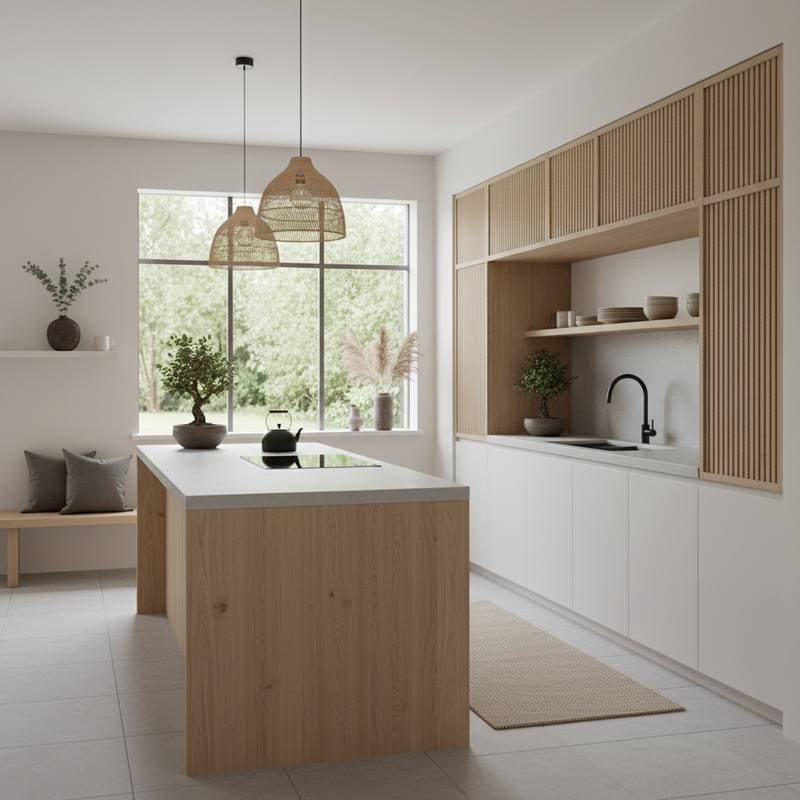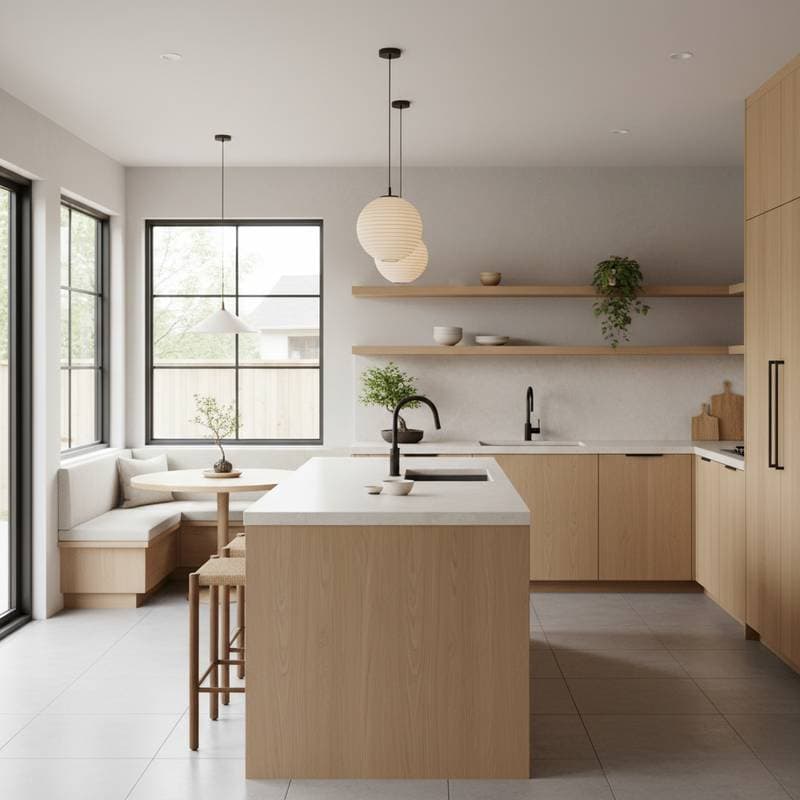Japandi Kitchens: Serenity in the Scandinavian-Japanese Blend
Consider your current kitchen setup, with its array of gadgets, varied cabinet styles, and bright overhead lights. You seek a balance of warmth and simplicity. Japandi design addresses this need by merging the practical aspects of Scandinavian aesthetics with the serene minimalism of Japanese influences, resulting in a space that promotes peace and efficiency.
A Japandi kitchen extends beyond visual appeal. It influences your experience during meal preparation, dining, or quiet moments with a beverage. The objective is to craft an environment that fosters relaxation alongside purposeful activity. The following sections outline steps to incorporate this harmonious style into your home.
Understanding the Japandi Approach
Japandi draws from two traditions that emphasize simplicity and organic elements. Scandinavian principles prioritize comfort, illumination, and practicality, whereas Japanese methods highlight equilibrium, skilled workmanship, and tranquility. This fusion yields a design that remains warm and uncluttered, pristine yet welcoming.
Key elements in a Japandi kitchen include:
- Neutral palettes such as soft whites, beiges, taupes, and light grays
- Organic substances like timber, stone, earthenware, and flax fabrics
- Practical arrangements that minimize disarray and honor artisanal quality
- Gentle fabrics that offset sleek planes with cozy sensations
Such features transform the kitchen into a refuge rather than a mere utility area.
Planning Your Japandi Kitchen Layout
Commence with spatial organization before selecting surfaces or fixtures. In Japandi, movements occur smoothly and deliberately. View the kitchen as interconnected areas rather than separate posts.
Follow these strategies:
- Streamline operations by linking preparation, cooking, and cleanup zones to shorten travel distances.
- Enhance openness by eliminating overhead storage or opting for exposed racks, which promote a sense of expansiveness.
- Combine meal preparation and eating spaces through a central peninsula or bar stools.
- Position elements to capture maximum natural illumination, ensuring windows remain unobstructed by dense coverings.
For compact areas, emphasize utility above all. Japanese-inspired compact designs achieve spaciousness through smart configurations and reduced excess.
Material and Color Choices
Selections in substances and hues establish the ambiance of your Japandi kitchen. Prioritize elements that develop patina over time and provide sensory engagement.
Recommended options encompass:
- Timber varieties like oak, ash, or birch for storage units and racks; their subtle shades align with Nordic traditions, while natural patterns offer dimension.
- Stone types with subdued finishes, such as polished granite or soapstone for worktops; steer clear of reflective polishes that amplify glare.
- Earthen items including artisanal tiles or vessels, which introduce understated diversity and coziness.
- Fabrics like flax drapes, cotton pads for seating, or jute mats to temper rigid planes.
Maintain a palette rooted in the environment, featuring creamy wall coatings, light timber shades, and soil-inspired neutrals. Introduce subtle accents in subdued verdure or slate to provide contrast while preserving composure.
Balancing Minimalism and Warmth
Individuals often fear that pared-down designs appear chilly or barren. Japandi counters this by integrating precise forms with inherent ease. Success lies in moderation, not void.
Achieve equilibrium through these methods:
- Maintain bare planes, yet position select meaningful objects, like a hand-thrown dish or timber board for slicing.
- Select illumination that diffuses gently, such as amber-toned LEDs or lantern-inspired suspensions.
- Layer fabrics for variety; pair polished stone tops with interlaced containers or flax linens to generate appeal sans excess.
Each object must fulfill a function or evoke subtle pleasure. Items lacking utility or delight have no place on visible surfaces.
Budget and Cost Considerations
Implement Japandi at varying expense tiers based on substance quality and execution.
- Entry-level updates: Allocate $5,000 to $10,000 for retaining the base structure while refreshing coatings with neutral paints, installing basic exposed storage, and applying economical timber-mimicking overlays.
- Moderate overhaul: Budget $15,000 to $30,000 to swap storage, surfaces, and fixtures using superior organic components.
- High-end transformation: Plan for $40,000 and above in a comprehensive redesign featuring durable timber units, lithic tops, and custom artisanal details.
Regional labor rates fluctuate, and organic materials often demand expert fitting. Consult area regulations and secure necessary approvals prior to significant alterations.
Safety and Maintenance Tips
Japandi prioritizes tranquil visuals, yet security and longevity remain paramount. Timber surfaces require periodic conditioning to withstand dampness. Lithic planes benefit from protective sealants against marks. Opt for traction-providing floors, including patterned ceramics or treated bark composites.
Illuminate task zones adequately with discreet under-unit LED fixtures that conserve energy. Anchor exposed storage firmly to wall supports to avoid instability. Engage certified experts for wiring or piping modifications. Homeowners proficient in basic tasks can manage aesthetic enhancements, but foundational systems demand professional oversight.
Adding Personal Touches
Despite its restrained base, a Japandi kitchen allows for individuality. It mirrors your habits and priorities. Thoughtful additions personalize the area without disrupting harmony.
Incorporate these elements:
- A container-grown miniature tree or culinary foliage for verdant notes
- An artisanal infuser or sculpted dish on display shelves
- Interlaced perches or seats with fiber upholstery
- A streamlined holder for seasonings and essences positioned tidily
These details infuse vitality while upholding restraint.
Living with Your Japandi Kitchen
Upon completion, observe how the space alters everyday patterns. Meal assembly becomes straightforward with designated spots for tools. Upkeep requires minimal effort due to orderly surfaces. The design promotes deliberate, attentive practices.
Sustain the environment by:
- Wiping planes clear at day's end.
- Concealing minor devices when unused.
- Limiting ornaments to purposeful selections.
- Conditioning timber regularly to retain allure.
Gradually, the kitchen transcends appearance. It nurtures a lifestyle centered on attentiveness, restraint, and ease.
Implementing Your Design Vision
Developing a Japandi kitchen involves crafting a genuine, equilibrated haven rather than following fleeting modes. Initiate modestly, perhaps by updating pulls or applying serene coatings. By uniting Nordic coziness with Eastern poise, you fashion more than an attractive room. You establish a domain that soothes thoughts, aids routines, and radiates understated elegance with each entry.










